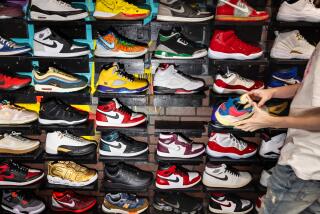These Shoes Were Made for Stomping
- Share via
The 3,800 participants at the 16th annual National Clogging Convention in Las Vegas this week would like to clear up a few misconceptions about the modern American clogger.
First, forget the wooden shoes.
The modern American clogger doesn’t dance in the heavy elfin footwear traditionally worn by the Dutch. The modern American clogger prefers a thick-heeled, double-layered tap shoe that makes a satisfying ka-clink when struck against the floor.
And while modern clogging is rooted in Appalachian folk dance, don’t picture cloggers in overalls and floppy hats stomping along to bands of banjos and washboards.
When 500 cloggers perform Saturday night at the Rio Hotel as part of the convention’s “clogging spectacular,” they will dance to the booming beats of the Backstreet Boys, Big Bad Voodoo Daddy and ZZ Top.
Most important, don’t think of clogging as a mere hobby. For many, clogging is a calling.
“Clogging validates why I’m on the planet,” says Grayce Bice, a 41-year-old operations supervisor with the Social Security Administration in Whittier. “When you’re clogging, you’re dancing from your soul.”
Bice remembers the precise moment 18 years ago when she caught the clogging bug.
“I was hard core into the disco scene,” she says. “That was my thing. But one night a friend took me to a place called the Silver Saddle Saloon in La Habra. I thought I couldn’t listen to the stuff they were playing, much less dance to it. It was too wangy-twangy. Then this guy hit the floor and started hammering out this amazing sound. I couldn’t believe anyone’s feet could make such a rhythm.”
Bice enrolled in a beginner’s class at her local YWCA, then started going to classes around Orange County.
“Pretty soon I was dancing four nights a week,” she says. “It became an obsession.”
Soon Bice hooked up with a fleet-footed clogger named Eric. He loved clogging so much that he’d dance in supermarket aisles and parking lots, as long as the surface was sweet. Their relationship blossomed along with their dancing. Eric became a top national performer, and Grayce became an instructor and director of a competitive youth clogging team called Buckshot: The Next Generation. The two are now married and divide their ample energies among three miniature schnauzers and clogging events across the country.
“Clogging has totally opened my world,” Bice says. “For instance, I had never been to Missouri. That’s a really great state, you know?”
Clogging is much more popular in Midwestern and Southern states than in Southern California, says Russ Hunsaker, president of the Southern California Clogging Assn. There are about 20 local clubs, ranging from the Sea View Cloggers in Ventura to the Apple Creek Cloggers in Orange County. Some dancers are members of multiple groups. Michelle Gagnon, a 24-year-old physical therapist who lives in North Hollywood, drives some 180 miles a week to keep up with her clogging in towns as far-flung as Camarillo and Garden Grove.
In class, a caller leads a “herd” of dancers through a series of steps, from the tap dance basic shuffle-ball-change to elaborate moves with names like the kicking vine slide, the donkey and the double-double.
During the five-day convention, cloggers dance in workshops and competitions. Top dancers, including Ira Bernstein of Malvern, N.Y. (whom Hunsaker calls “the PhD of percussive dance”), lead workshops and lectures, while tables outside the halls are piled high with instructional videos with titles such as “Advanced Steps That Sizzle” and “Clogging for His Glory.”
Part of the attraction of the convention is learning the new steps that are constantly being added to the clogging canon. Dancers incorporate moves from tap or Irish dance (the “Riverdance” craze took the clogging community by storm).
“We encourage people to paint outside the lines,” Hunsaker says.
So many people misunderstand what clogging is, that a name change is probably in order, he says.
“I prefer the name ‘American step dancing,’ ” Hunsaker says. “If you tell someone you’re into ‘American step dancing,’ they don’t think you’re clomping around in big wooden shoes.”
More to Read
Sign up for Essential California
The most important California stories and recommendations in your inbox every morning.
You may occasionally receive promotional content from the Los Angeles Times.













